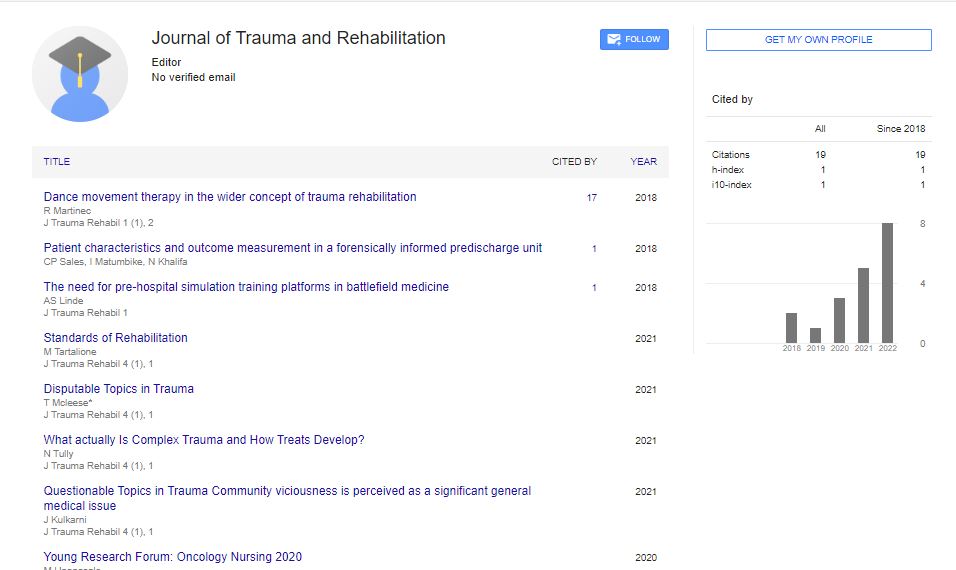Commentary, J Trauma Rehabil Vol: 6 Issue: 2
Management of Orthopaedic Trauma: From Diagnosis to Rehabilitation
Sanjit Ganta*
1Department of Orthopedic and Trauma Surgery, Cantonal Hospital of Lucerne, Lucerne, Switzerland
*Corresponding Author: Sanjit Ganta,
Department of Orthopedic and Trauma
Surgery, Cantonal Hospital of Lucerne, Lucerne, Switzerland, United States of
America
E-mail: sanjit.ganta32@hotmail.com
Received date: 29 May, 2023, Manuscript No. JTR-23-106877;
Editor assigned date: 31 May, 2023, PreQC No. JTR-23-106877 (PQ);
Reviewed date: 14 June, 2023, QC No. JTR-23-106877;
Revised date: 21 June, 2023, Manuscript No. JTR-23-106877 (R);
Published date: 28 June, 2023, DOI: 10.4172/Jtr.1000124
Citation: Ganta S (2023) Management of Orthopaedic Trauma: From Diagnosis to Rehabilitation. J Trauma Rehabil 6:2.
Description
Orthopaedic trauma refers to injuries involving the bones, joints, and soft tissues, often resulting from accidents, falls, sports-related incidents, or other sudden events. Effective management of orthopaedic trauma is vital to achieving optimal outcomes for patients. This comprehensive approach involves a series of steps, from accurate diagnosis and timely interventions to post-injury rehabilitation.
Diagnosis and assessment
The first step in managing orthopaedic trauma is a thorough and accurate diagnosis. A prompt and precise assessment enables healthcare professionals to determine the extent of the injury, identify any associated complications, and devise an appropriate treatment plan. The diagnosis involves:
Medical history: Gathering information about the circumstances of the injury, the patient's medical history, and any pre-existing conditions is essential in understanding the context of the trauma.
Physical examination: A comprehensive physical examination is conducted to assess the injured area, detect any deformities, and identify points of tenderness or swelling.
Imaging studies: X-rays, Computerized Tomography (CT) scans, and Magnetic Resonance Imaging (MRI) scans are commonly used to visualize the bones and soft tissues, providing detailed information about the extent of the injury.
Additional tests: In some cases, blood tests or other diagnostic procedures may be necessary to evaluate overall health and screen for potential complications.
Acute treatment and stabilization
Once the diagnosis is established, immediate treatment and stabilization are vital to prevent further damage and alleviate pain. The goals of acute treatment include:
Immobilization: Immobilizing the injured area using splints, braces, or casts helps stabilize the bones and tissues, reducing the risk of further injury.
Closed reduction: In some cases, the bones may need to be realigned through closed reduction, a non-surgical procedure where the healthcare professional manipulates the bones back into their proper position.
Surgical intervention: Severe fractures or complex injuries may require surgical intervention. Surgery aims to restore anatomical alignment, stability, and function of the injured area.
Pain management: Managing pain and discomfort is essential for the patient's well-being. Pain medication and other pain management techniques are employed as needed.
Postoperative care and rehabilitation
Following surgical intervention or the acute treatment phase, postoperative care and rehabilitation become important for the patient's recovery and functional restoration. This phase involves:
Wound care: Proper wound care is essential to prevent infections and promote healing. Keeping the surgical site clean and monitoring for any signs of infection are essential components of postoperative care.
Physical therapy: Physical therapy plays a vital role in rehabilitation. It involves targeted exercises and therapies to improve strength, range of motion, and functional abilities.
Weight-bearing and mobility: Gradual weight-bearing and mobility are introduced based on the type of injury and the patient's progress. This helps prevent complications like muscle atrophy and joint stiffness.
Assistive devices: The use of assistive devices, such as crutches, canes, or walkers, may be recommended to aid in walking and reduce pressure on the injured area during the recovery phase.
Long-term monitoring and follow-up
Even after the initial recovery period, long-term monitoring and follow-up are essential to assess the patient's progress, identify any complications, and address any ongoing concerns. Regular follow-up visits with orthopaedic specialists help ensure that the patient continues to recover and regain full function.
Psychological support
Orthopaedic trauma can be emotionally challenging for patients, impacting their mental well-being and quality of life. Psychological support is vital to address any emotional distress or anxiety related to the injury. Counseling or support groups can help patients cope with the trauma and manage their recovery more effectively.
Rehabilitation for complex injuries
In cases of severe or complex orthopaedic trauma, rehabilitation may involve a multidisciplinary team of specialists, including orthopaedic surgeons, physical therapists, occupational therapists, and psychologists. Collaborative efforts aim to optimize the patient's recovery, providing comprehensive care for both physical and emotional aspects of healing.
Conclusion
The management of orthopaedic trauma is a multi-faceted process that requires a comprehensive and coordinated approach. From accurate diagnosis and prompt treatment to rehabilitation and psychological support, each phase plays an important role in the patient's recovery journey. Timely intervention, skilled surgical
techniques, and attentive rehabilitation can lead to successful outcomes and a return to a functional and fulfilling life for individuals affected by orthopaedic trauma. Collaborative efforts between healthcare professionals and the patient are key to achieving optimal results and restoring quality of life after an orthopaedic injury. Spanish
Spanish  Chinese
Chinese  Russian
Russian  German
German  French
French  Japanese
Japanese  Portuguese
Portuguese  Hindi
Hindi 